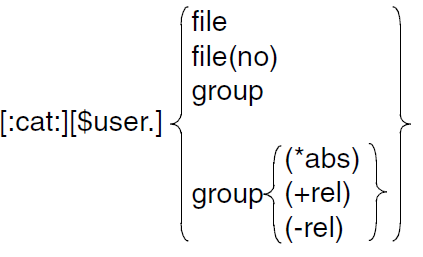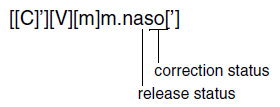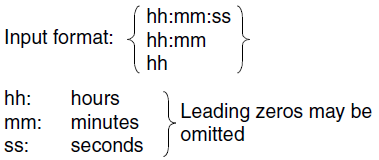The following example shows the representation of the syntax of a command in a manual.
The command format consists of a field with the command name. All operands with their legal values are then listed. Operand values which introduce structures and the operands dependent on these operands are listed separately.
HELP-SDF Alias: HPSD | ||||||||||||||||||||||||||||||||||||||||||||||||||||
| ||||||||||||||||||||||||||||||||||||||||||||||||||||
This syntax description is valid for SDF V4.6A.The syntax of the SDF command/statement language is explained in the following three tables.
Table 1: Notational conventions
The meanings of the special characters and the notation used to describe command and statement formats are explained in Table 1.
Table 2: Data types
Variable operand values are represented in SDF by data types. Each data type represents a specific set of values. The number of data types is limited to those described in Table 2.
The description of the data types is valid for the entire set of commands/statements.
Therefore only deviations (if any) from the attributes described here are explained in the relevant operand descriptions.
Table 3: Suffixes for data types
Data type suffixes define additional rules for data type input. They contain a length or interval specification and can be used to limit the set of values (suffix begins with without), extend it (suffix begins with with), or declare a particular task mandatory (suffix begins with mandatory). The following short forms are used in this manual for data type suffixes:
cat-id completion correction-state generation lower-case manual-release odd-possible path-completion separators temporary-file underscore user-id version wildcard-constr wildcards | cat compl corr gen low man odd path-compl sep temp-file under user vers wild-constr wild |
The description of the ‘integer’ data type in Table 3 contains a number of items in italics; the italics are not part of the syntax and are only used to make the table easier to read.
For special data types that are checked by the implementation, Table 3 contains suffixes printed in italics (see the special suffix) which are not part of the syntax.
The description of the data type suffixes is valid for the entire set of commands/statements. Therefore only deviations (if any) from the attributes described here are explained in the relevant operand descriptions.
Metasyntax
Representation | Meaning | Examples | |||||||||||||||||||||||||||||||||||
|---|---|---|---|---|---|---|---|---|---|---|---|---|---|---|---|---|---|---|---|---|---|---|---|---|---|---|---|---|---|---|---|---|---|---|---|---|---|
| UPPERCASE LETTERS | |||||||||||||||||||||||||||||||||||||
| Uppercase letters denote keywords (command, statement or operand names, keyword values) and constant operand values. Keyword values begin with *. | |||||||||||||||||||||||||||||||||||||
HELP-SDF SCREEN-STEPS = *NO | |||||||||||||||||||||||||||||||||||||
| UPPERCASE LETTERS in boldface= | |||||||||||||||||||||||||||||||||||||
| Uppercase letters printed in boldface denote guaranteed or suggested abbreviations of keywords. | |||||||||||||||||||||||||||||||||||||
| GUIDANCE-MODE = *YES | |||||||||||||||||||||||||||||||||||||
| = | |||||||||||||||||||||||||||||||||||||
| The equals sign connects an operand name with the associated operand values. | |||||||||||||||||||||||||||||||||||||
| GUIDANCE-MODE = *NO | |||||||||||||||||||||||||||||||||||||
| < > | |||||||||||||||||||||||||||||||||||||
| Angle brackets denote variables whose range of values is described by data types and suffixes (see Tables 2 and 3). | |||||||||||||||||||||||||||||||||||||
| SYNTAX-FILE = <filename 1..54> | |||||||||||||||||||||||||||||||||||||
| Underscoring | |||||||||||||||||||||||||||||||||||||
| Underscoring denotes the default value of an operand. | |||||||||||||||||||||||||||||||||||||
| GUIDANCE-MODE = *NO | |||||||||||||||||||||||||||||||||||||
| / | |||||||||||||||||||||||||||||||||||||
| A slash serves to separate alternative operand values. | |||||||||||||||||||||||||||||||||||||
| NEXT-FIELD = *NO / *YES | |||||||||||||||||||||||||||||||||||||
| (...) | |||||||||||||||||||||||||||||||||||||
| Parentheses denote operand values that initiate a structure. | |||||||||||||||||||||||||||||||||||||
| ,UNGUIDED-DIALOG = *YES (...) / *NO | |||||||||||||||||||||||||||||||||||||
| [ ] | |||||||||||||||||||||||||||||||||||||
| Square brackets denote operand values which introduce a structure and are optional. The subsequent structure can be specified without the initiating operand value. | |||||||||||||||||||||||||||||||||||||
| SELECT = [*BY-ATTRIBUTES](...) | |||||||||||||||||||||||||||||||||||||
| Indentation | |||||||||||||||||||||||||||||||||||||
| Indentation indicates that the operand is dependent on a higherranking operand. | |||||||||||||||||||||||||||||||||||||
| |||||||||||||||||||||||||||||||||||||
| | |||||||||||||||||||||||||||||||||||||
A vertical bar identifies related operands within a structure. Its length marks the beginning and end of a structure. A structure may contain further structures. The number of vertical bars preceding an operand corresponds to the depth of the structure. | |||||||||||||||||||||||||||||||||||||
| |||||||||||||||||||||||||||||||||||||
| ' | |||||||||||||||||||||||||||||||||||||
A comma precedes further operands at the same structure level. | |||||||||||||||||||||||||||||||||||||
GUIDANCE-MODE = *NO / *YES ,SDF-COMMANDS = *NO / *YES | |||||||||||||||||||||||||||||||||||||
| list-poss(n): | |||||||||||||||||||||||||||||||||||||
The entry “list-poss” signifies that a list of operand values can be given at this point. If (n) is present, it means that the list must not have more than n elements. A list of more than one element must be enclosed in parentheses. | |||||||||||||||||||||||||||||||||||||
list-poss: *SAM / *ISAM list-poss(40): <structured-name 1..30> list-poss(256): *OMF / *SYSLST(...) /<filename1..54> | |||||||||||||||||||||||||||||||||||||
| Alias: | |||||||||||||||||||||||||||||||||||||
The name that follows represents a guaranteed alias (abbreviation) for the command or statement name. | |||||||||||||||||||||||||||||||||||||
| HELP-SDF Alias: HPSDF | |||||||||||||||||||||||||||||||||||||
Data types
Data type | Character set | Special rules | ||||||
|---|---|---|---|---|---|---|---|---|
alphanum-name | A...Z 0...9 $, #, @ | |||||||
cat-id | A...Z 0...9 | Not more than 4 characters; must not begin with the string PUB | ||||||
command-rest | freely selectable | |||||||
composed-name | A...Z 0...9 $, #, @ hyphen period catalog ID | Alphanumeric string that can be split into multiple substrings by means of a period or hyphen. If a file name can also be specified, the string may begin with a catalog ID in the form :cat: (see data type filename). | ||||||
c-string | EBCDIC character | Must be enclosed within single quotes; the letter C may be prefixed; any single quotes occurring within the string must be entered twice. | ||||||
date | 0...9 Structure identifier: hyphen | Input format: yyyy-mm-dd
| ||||||
device | A...Z 0...9 hyphen | Character string, max. 8 characters in length, corresponding to a device available in the system. In guided dialog, SDF displays the valid operand values. For notes on possible devices, see the relevant operand description. | ||||||
fixed | +, - 0...9 period | Input format: [sign][digits].[digits]
must contain at least one digit, but may contain up to 10 characters (0...9, period) apart from the sign. | ||||||
filename | A...Z 0...9 $, #, @ hyphen period | Input format: :cat: optional entry of the catalog identifier; character set limited to A...Z and 0...9; maximum of 4 characters; must be enclosed in colons; default value is the catalog identifier assigned to the user ID, as specified in the user catalog. $user. optional entry of the user ID; $. (special case) system default ID file file or job variable name; may be split into a number of partial names using a period as a delimiter: name1[.name2[...]] file can have a maximum length of 41 characters; it must not begin with a $ and must include at least one character from the range A...Z.
# or @ used as the first character indicates temporary files or job variables, depending on system generation. file(no) tape file name no: version number; character set is A...Z, 0...9, $, #, @. Parentheses must be specified. group name of a file generation group (character set: as for “file”) (*abs) absolute generation number (1-9999); * and parentheses must be specified. (+rel) (-rel) relative generation number (0-99); sign and parentheses must be specified. | ||||||
| integer | 0…9, +, - | + or -, if specified, must be the first character. | ||||||
name | A...Z 0...9 $, #, @ | Must not begin with 0...9. | ||||||
partial-filename | A...Z 0...9 $, #, @ hyphen period | Input format: [:cat:][$user.][partname.] :cat: $user. see filename partname optional entry of the initial part of a name common to a number of files or file generation groups in the form: name1.[name2.[...]] The final character of “partname” must be a period. At least one of the parts :cat:, $user. or partname must be specified. | ||||||
posix-filename | A...Z 0...9 special characters | String with a length of up to 255 characters; consists of either one or two periods or of alphanumeric characters and special characters. The special characters must be escaped with a preceding \ (backslash); the / is not allowed. Must be enclosed within single quotes if alternative data types are permitted, separators are used, or the first character is a ?, ! or ^. A distinction is made between uppercase and lowercase. | ||||||
posix-pathname | A...Z 0...9 special characters structure identifier: slash | Input format: [/]part1/.../partn i max. 1023 characters; must be enclosed within single quotes if alternative data types are permitted, separators are used, or the first character is a ?, ! or ^. | ||||||
product-version | A...Z 0...9 period single quote |
where m, n, s and o are all digits and a is a letter. Whether the release and/or correction status may/must be specified depends on the suffixes to the data type (see suffixes without-corr, without-man, mandatory-man and mandatorycorr in Table 3). product-version may be enclosed within single quotes (possibly with a preceding C). The specification of the version may begin with the letter V. | ||||||
structured-name | A...Z 0...9 $, #, @ hyphen | Alphanumeric string which may comprise a number of substrings separated by a hyphen. First character: A...Z or $, #, @ | ||||||
text | freely selectable | For the input format, see the relevant operand descriptions. | ||||||
time | 0...9 structure identifier: colon | Time-of-day entry: | ||||||
vsn |
| a) Input format: pvsid.sequence-no
b) Max. 6 characters; PUB may be prefixed, but must not be followed by $, #, @. | ||||||
x-string | Hexadecimal: 00...FF | Must be enclosed in single quotes; must be prefixed by the letter X. There may be an odd number of characters. | ||||||
x-text | Hexadecimal: 00...FF | Must not be enclosed in single quotes; the letter X must not be prefixed. There may be an odd number of characters. | ||||||
Suffixes for data types
Suffix | Meaning | ||||||||||||||||||||||||||||||
|---|---|---|---|---|---|---|---|---|---|---|---|---|---|---|---|---|---|---|---|---|---|---|---|---|---|---|---|---|---|---|---|
x..y unit | With data type “integer”: interval specification
| ||||||||||||||||||||||||||||||
| x..y special | With the other data types: length specification For data types catid, date, device, product-version, time and vsn the length specification is not displayed.
| ||||||||||||||||||||||||||||||
with | Extends the specification options for a data type. | ||||||||||||||||||||||||||||||
-compl | When specifying the data type “date”, SDF expands two-digit year specifictions in the form yy-mm-dd to:
| ||||||||||||||||||||||||||||||
-low | Uppercase and lowercase letters are differentiated. | ||||||||||||||||||||||||||||||
-path-compl | For specifications for the data type “filename”, SDF adds the catalog and/or user ID if these have not been specified. | ||||||||||||||||||||||||||||||
-under | Permits underscores (_) for the data type “name”. | ||||||||||||||||||||||||||||||
-wild(n) | Parts of names may be replaced by the following wildcards. n denotes the maximum input length when using wildcards. Due to the introduction of the data types posix-filename and posixpathname, SDF now accepts wildcards from the UNIX world (referred to below as POSIX wildcards) in addition to the usual BS2000 wildcards. However, as not all commands support POSIX wildcards, their use for data types other than posix-filename and posix-pathname can lead to semantic errors. Only POSIX wildcards or only BS2000 wildcards should be used within a search pattern. Only POSIX wildcards are allowed for the data types posixfilename and posix-pathname. If a pattern can be matched more than once in a string, the first match is used.
| ||||||||||||||||||||||||||||||
-wild-constr(n) | Specification of a constructor (string) that defines how new names are to be constructed from a previously specified selector (i.e. a selection string with wildcards). See also with-wild. n denotes the maximum input length when using wildcards.
Allocation of wildcards to corresponding wildcards in the selector: All wildcards in the selector are numbered from left to right in ascending order (global index). Identical wildcards in the selector are additionally numbered from left to right in ascending order (wildcard-specific index). Wildcards can be specified in the constructor by one of two mutually exclusive methods:
The following rules must be observed when specifying a constructor:
Examples:
1The period at the end of the name may violate naming conventions (e.g. for fully-qualified file names). | ||||||||||||||||||||||||||||||
| without | Restricts the specification options for a data type. | ||||||||||||||||||||||||||||||
-cat | Specification of a catalog ID is not permitted. | ||||||||||||||||||||||||||||||
-corr | Input format: [[C]’][V][m]m.na[’] Specifications for the data type product-version must not include the correction status. | ||||||||||||||||||||||||||||||
-gen | Input format: [[C]’][V][m]m.n[’] | ||||||||||||||||||||||||||||||
-man | Specifications for the data type product-version must not include either release or correction status. | ||||||||||||||||||||||||||||||
-odd | The data type x-text permits only an even number of characters. | ||||||||||||||||||||||||||||||
-sep | With the data type “text”, specification of the following separators is not permitted: ; = ( ) < > 'BLANK' (i.e. semicolon, equals sign, left and right parentheses, greater than, less than, and blank). | ||||||||||||||||||||||||||||||
-tempfile | Specification of a temporary file is not permitted (see #file or @file under filename). | ||||||||||||||||||||||||||||||
-user | Specification of a user ID is not permitted. | ||||||||||||||||||||||||||||||
-vers | Specification of the version (see “file(no)”) is not permitted for tape files. | ||||||||||||||||||||||||||||||
-wild | The file types posix-filename and posix-pathname must not contain a pattern (character). | ||||||||||||||||||||||||||||||
| mandatory | Certain specifications are necessary for a data type. | ||||||||||||||||||||||||||||||
-corr | Input format: [[C]’][V][m]m.naso[’] Specifications for the data type product-version must include the correction status and therefore also the release status. | ||||||||||||||||||||||||||||||
-man | Input format: [[C]’][V][m]m.na[so][’] Specifications for the data type product-version must include the release status. Specification of the correction status is optional if this is not prohibited by the use of the suffix without-corr. | ||||||||||||||||||||||||||||||
-quotes | Specifications for the data types posix-filename and posix-pathname must be enclosed in single quotes. | ||||||||||||||||||||||||||||||




